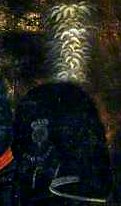In his Fashioning Regulation (see previous post) Ben Townsend notes that in the British service of the eighteen-noughties and teens the alien moustache was generally regarded as a Germanic import. But it seems also that, for some, such foreignness could take on an oppressively political significance – at least judging by a curious episode first chronicled in Wooler’s British Gazette and The Black Dwarf, the papers of the radical satirist Thomas J Wooler, and then picked up widely by the mainstream press of the day.
At the termination of their spell of permanent duty in June 1819, Colonel Lord Grantham had made the customary speech to his regiment of West Yorkshire Yeomanry, lately re-branded as the Yorkshire Hussars (again, see previous post), remarking that –
He could not detain them long in alluding to a circumstance so trifling in itself, as the wearing mustachios on the upper lip, which had been stigmatized by certain persons as an attempt to Germanize them. The fact was, that he, as commander of the regiment, had no wish, nor issued any orders on the subject, but it had arisen from the right feeling and good sense of the corps; who when they had taken the name of Hussars thought they ought also to assume their appearance. He was perfectly aware the existence of such a regiment was not a very agreeable circumstance to certain persons in the neighbourhood …

Such persons, he warned his men darkly, would oppose them “by striving to impress upon their minds that they were the whiskered tools of power.”
But he trusted if ever they had to cut down those gentry, they would let them know that although they were hairy on the upper lip, they could shave close.
(Despite this, he concluded by suggesting that, as farmers, they might opt to lose the moustaches.) This provocation (coming just a few weeks before Peterloo) was promptly picked up by Wooler in The Black Dwarf of 30 June in a commentary couched in “the most insulting and irritating language, though perhaps … not … within the legal and technical character of a libel”. The freshly moustachioed yeomanry, declared Wooler, were –
… things who dare not be men, lest his Lordship should be offended … fawning dependants, or the subtle slaves of the great, with a few fools, and a larger proportion of coxcombs.
There was much more of the same. On 10 July an unidentified stranger appeared at Wooler’s Fleet Street office, demanding to see the writer of the offending article. Wooler “in his usually facetious manner [responded] lightly, and with indifference”. The stranger furiously demanded a published apology for the “scurrilously abusive” language. Wooler challenged him to prove that it was so.

Cruikshank’s topical cartoon [British Museum] has Grantham as a Herculean (and fully mustachioed) giant belabouring Wooler as the Black Dwarf
At this point things turned physical, the complainant aiming several blows with his cane, and Wooler making “a spirited resistance”. The noise of the fight brought up some compositors and printers from downstairs, who collared the attacker; he declined to give his name but offered a visiting card, revealing himself to be Lord Grantham of St James Square.
A Lord! A Lord! escaped involuntarily, with a burst of laughter, from the bye-standers; and … in pity to the title, he was suffered to depart, amid the derision of the spectators …
 Some papers expected the affair to be revived in court, but in the event Wooler printed a grudging retraction. On one of Grantham’s own images of his Hussars (above, and see previous post) appears a hint of fluff on an upper lip, though a painting of the period at the National Army Museum has distinct moustaches all round.
Some papers expected the affair to be revived in court, but in the event Wooler printed a grudging retraction. On one of Grantham’s own images of his Hussars (above, and see previous post) appears a hint of fluff on an upper lip, though a painting of the period at the National Army Museum has distinct moustaches all round.
Various accounts of this incident appear in, among others, Bell’s Weekly Messenger of 12 July 1819, the Staffordshire Advertiser of 17 July, the Leeds Intelligencer of the 19th, and the Westmorland Gazette and Yorkshire Gazette of
the 24th.









